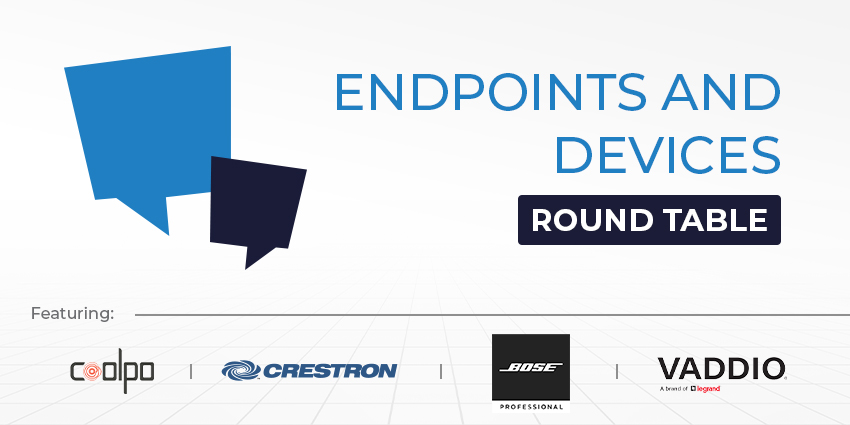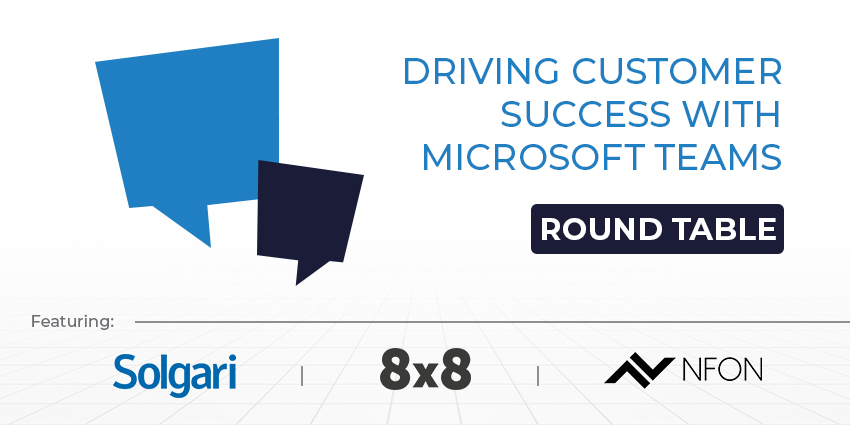The united communications and collaboration industry is only as innovative and boundary-pushing as the endpoints and devices that operate them.
Innovative and boundary-pushing the endpoints and devices market certainly is. From the growth of mobile-centric solutions to Internet of Things (IoT) integration to (you guessed it) the introduction of AI and machine learning capabilities, the industry invention is constant as every new endpoint and device seeks to push UC and collaboration further into the future.
With our latest UC Round Table subject, “Endpoints and Devices”, we spoke with experts and executives from Crestron, Coolpo, Bose Professional and Vaddio about the key trends in the market for UC endpoints and devices, the challenges presented by the rise of hybrid and remote working, the efforts to ensure seamless integration and interoperability, and the impact of AI on endpoints and devices.
What recent trends have you observed in the endpoints and devices market for unified communications, and how are these trends impacting businesses?

Ray Zhu, CEO at Coolpo
Zhu commented that Coolpo noticed the emergence of “innovative vendors that offer automated video generation based on user text and pictures”.
“For instance, there is a specific vendor that enables users to create customized ‘hello videos’,” Zhu explained. “These videos can be incorporated into email marketing campaigns, enhancing customer interactions through visual communication.”
Zhu stressed that this type of technology could revolutionise UC and different areas of business operations, especially customer service. “Picture this scenario,” Zhu elaborated, “a customer believes they are engaging in a video call with a real human agent, but in reality, it could be an AI-generated customer service representative providing answers related to products and services.”
“This automation can streamline after-service and Business Process Outsourcing (BPO) operations, leading to more efficient and effective interactions with customers,” Zhu continued.
Eric Wagner, Product Marketing Manager at Bose Professional
Wagner highlighted that the lower cost of technology levels the playing field for more businesses. “It’s easier and more affordable for organisations of all sizes to provide high-quality audio and video conferencing capabilities to their employees,” Wagner said. “This is especially important for small businesses that may not have the resources of larger organisations.”
Wagner also suggested that all-in-one conferencing technology offers a plug-and-play experience, catering to most workers’ comfort in joining meetings from their laptops: “People want to walk into a meeting space, connect quickly and start the call with clear, natural-sounding audio and high-quality video. Consistently providing this moves the focus away from any thought of making sure the technology works and keeps it focused on providing a simple yet engaging meeting experience.”
Sam Kennedy, Senior Director, Product Marketing at Crestron
Kennedy first outlined the massive growth in the need for this technology. “We’ve heard from our customers that there’s an ongoing need to set up as many rooms as possible to enable hybrid work,” Kennedy said. “In the past, a business may have had 10% of all its rooms being utilized for collaboration. Now we’re hearing customers say, ‘I want 50% of my rooms or all of my rooms to be enabled’.”
That initial trend catalyses the second theme Kennedy identified, growing demand for high-quality experiences. “During the pandemic, businesses were in survival mode,” he expanded. “We saw ‘quick and dirty’ solutions with inexpensive webcams being set up, and now there’s a need for the correct solution for an end user. That includes excellent audio — speakers and microphones — and video solutions that allow both remote and in-person attendees to stay engaged in a hybrid meeting.”
David Albright, Sr. Business Development Manager, Hybrid Collaboration & Learning at Legrand and Vaddio
Albright highlighted all-in-one devices, including video bars and interactive displays with integrated cameras, speakers, and microphones.
“However, it’s important to highlight that while these solutions may simplify installations and the user experience, quality may be compromised,” Albright added. “Where premium quality is critical, a customizable solution may be better suited.”
“Another priority is the ease of use, shifting from bring-your-own-device rooms to whole-room systems with native Teams or Zoom operation,” he continued. “For hybrid meetings, AI-controlled video, intelligent spatial audio, and simpler connectivity ecosystems like Dante and Vaddio’s EasyIP can enhance the experience.”
With the rise of remote work and hybrid workplaces, what challenges do you foresee in terms of managing and securing and managing endpoints and devices?

Sam Kennedy, Senior Director, Product Marketing at Crestron
Kennedy agreed that it’s a problem, particularly for businesses with a multi-vendor strategy.
“If 50 percent of a company’s rooms utilize Crestron, 30 percent use Brand B, and 20 percent lean on Brand C, you’ll need multiple platforms to manage your technology,” Kennedy said.
“To give this more detail, suppose you have one manufacturer who’s created your video camera or collaboration bar, another for content distribution, and yet another for wireless content sharing — soon, you’re talking about three, four, or five management platforms,” he expanded. “Now multiply that issue across an enterprise, and you can quickly see how unwieldy that solution can become.”
Kennedy suggested a single-vendor strategy, as having all those same devices monitored and managed by one cloud platform and from a single pane of glass maximises efficiency.
“In Crestron’s case, for example, while we can certainly create an ecosystem that’s up to the challenge, we don’t build everything.,” Kennedy said. “That’s why our XiO Cloud product runs on third-party apps such as Sony and Samsung monitors, and we align with — and are certified by — platforms such as Zoom and Microsoft Teams.”
David Albright, Sr. Business Development Manager, Hybrid Collaboration & Learning at Legrand and Vaddio
Albright suggested that while ease of use helps create a seamless and productive experience for users, it also introduces another layer of technology that has to be managed.
“Thankfully, a lot of these devices can be managed remotely all from one place,” Albright clarified. “For example, the Vaddio Deployment Tool allows those who are responsible for overseeing our audio devices to see all devices on the network and their status, if any need updating, and which are being used.”
“This information can help to improve operational efficiencies as well as help to identify the most popular rooms,” Albright continued. “With the right tools, system managers can overcome any ease of use and monitoring challenges quickly.”
Ray Zhu, CEO at Coolpo
Zhu argued that the ideal model for such devices would integrate internet connectivity while ensuring robust security and privacy measures: “This would allow the device to perform self-evaluation and self-improvement and possibly even provide personalized assistance based on a comprehensive understanding of the user’s environment, facial expressions, and body language.”
“However, striking the right balance between convenience and security is a complex task,” Zhu added, “and the current market offers a multitude of devices with Wi-Fi and Bluetooth connectivity, particularly in meeting rooms and public spaces.”
Zhu recognises that there may be trade-offs between absolute security and seamless management because of such a delicate balance. “From our perspective, we strive to prioritize the safety and privacy of our users,” he explained. “Thus, we continue to refine our technology, incorporating self-evolution capabilities while being cautious about adopting Wi-Fi and Bluetooth features that may pose potential security risks.”
Eric Wagner, Product Marketing Manager at Bose Professional
Wagner suggested that as businesses evolve, security risks and measures continue to change in tandem. “This means endpoints and devices with network connectivity installed in home offices and remote locations could be points of potential network vulnerability,” he said. “Manufacturers need to continue to prioritise network security to decrease the risk of hacking threats.”
What measures are being taken to ensure interoperability and seamless integration among different endpoints and devices from various vendors in UC environments?

Eric Wagner, Product Marketing Manager at Bose Professional
Wagner underlined that customers increasingly want solutions from different manufacturers to work together and will “naturally gravitate towards those that are interoperable since they produce fewer headaches, which translates to being easier to work with”.
“Manufacturers like Bose Professional make sure conferencing devices like the VB-S and VB1 are certified or compatible with the most common conferencing platforms,” Wagner continued. “This provides peace of mind so people can use their preferred platform – Microsoft Teams, Zoom, Google Meet, and more – and focus on productive meetings with remote employees and clients.”
Ray Zhu, CEO at Coolpo
Zhu highlighted the upcoming release of Coolpo’s AI-based noise cancellation feature: “To promote accessibility, this cutting-edge feature will be offered free for an extended period, possibly up to a year.”
“The versatility of our AI models allows users to leverage them with ease,” Zhu added. “Any individual with a laptop, Mac, or PC can connect their device to a speaker and microphone, and our software can perform noise cancellation seamlessly. This empowers users to optimize their existing devices without the need for replacements or additional hardware.”
Zhu purported an example of a user having a high-quality speaker they don’t wish to replace with a Bluetooth alternative or if they have a microphone but without noise cancellation capabilities. “Coolpo’s software becomes a game-changer,” he said. “By harnessing the power of your local computer, you can now enable noise cancellation for all your connected devices without any wasteful investments.”
David Albright, Sr. Business Development Manager, Hybrid Collaboration & Learning at Legrand and Vaddio
Albright emphasised that “the ecosystem matters”, explaining that Vaddio had tested and certified its solutions with several partners, including Microsoft, Zoom, and Barco, to validate that its devices work seamlessly with their systems.
“Whether it be a Teams or Zoom certification, USB or Dante interoperability, or a Vaddio EasyIP ecosystem, those kinds of elements really help support seamless integration of the space,” Albright said.
“The heavy lifting is done to validate that X works with Y works with Z from manufacturers A, B, and C, and look nice in a room and function properly,” Albright continued. “Not only do these certifications simplify specification, configuration, and deployment, it also helps with the long-term management and serviceability of the system.”
Sam Kennedy, Senior Director, Product Marketing at Crestron
Kennedy believed there are several ways to accomplish seamless interoperability and integration. The first occurs at a platform level through the likes of Zoom, Teams, and Webex, as they include direct guest join functions.
“Another solution involves creating the ability to accommodate BYOD solutions at the device level, which is something we’ve introduced with our AirMedia Wireless Connect system,” Kennedy said. “What we’ve found is that many organizations want a combination of the two.”
Kennedy also suggested that the answer to a business’s distinct needs comes down to the type and number of collaborative sessions it’s conducting.
“If the majority of my meetings are all internal, a single platform is likely the best answer,” Kennedy said. “Let’s say 95 percent of my meetings are internal and 5 percent on some other platform — I’d simply lean on Direct Guest Join. However, if 80 percent of my calls are internal but 20 percent are external, that’s where deploying a solution at the device level makes a lot more sense. This will vary by organization, by groups within that organization, by room type, and by app.”
With the increasing adoption of artificial intelligence (AI) and machine learning in unified communications, how are endpoints and devices being augmented to deliver smarter and more personalised user interactions?

David Albright, Sr. Business Development Manager, Hybrid Collaboration & Learning at Legrand and Vaddio
Albright pinpointed the Microsoft Teams Front Row experience as an example of smarter and more personalised user interactions, as everyone is equally represented on screen and in a size large enough so that it feels more like a one-on-one conversation.
“AI-driven auto camera and audio tracking technologies help to manage this, but it’s been found that they can pick up unwanted audio or movement, such as a passerby,” Albright described.
“As a result, organizations have started turning off auto-tracking features, thereby eliminating any equitable meeting possibilities,” he added. “Vaddio Device Controller’s room mapping feature introduces AI customization to the UC market. Users can block out areas for the camera to ignore, addressing disruptive elements and enhancing the overall meeting experience.”
Sam Kennedy, Senior Director, Product Marketing at Crestron
Kennedy stressed AI’s massive impact, given that it “drives intelligent video, which switches cameras in a room and frames speakers for the remote worker so that everyone can see a speaker’s nonverbal cues”. As with Albright, Kennedy agreed that AI is ushering in the age of true meeting equity.
He has also been fascinated by Microsoft Copilot and its expansive possibilities. “Here’s a terrific example of how this program can work,” Kennedy suggested. “Imagine a meeting attendee joining a session a few minutes late. That attendee will receive a meeting recap that explains who’s contributed what to the session, who’s excited by a prospect, who’s dissatisfied with a particular aspect of a project, and so on. That’s just one aspect of what this technology can do, and it’s incredibly exciting.”
Eric Wagner, Product Marketing Manager at Bose Professional
Wagner and Bose are already leveraging AI, and Wagner confirmed that this will only increase in the future.
“Features like participant counting, auto framing, tracking who is speaking, and auto EQ are current examples of its use,” Wagner said. “The future possibilities are wide open, and as we continue to be more globally connected, AI will prove to be a power tool – from transcribing and providing subtitles in real-time to automatically adjusting the room environment for the ideal audio and on-camera experience. The next three-to-five years will prove to be very interesting and exciting in the UC space.”
Ray Zhu, CEO at Coolpo
Zhu suggested several advancements, including the development of voice-generated video content: “For hybrid and remote settings, individuals can customize avatars or animated videos driven by speech, modelling their appearance and features. This virtual version acts as a clone, speaking on their behalf in meetings, ensuring comfort and confidence.”
“In the future, we will also offer accent auto-generation, enabling users to speak naturally while the AI automatically adjusts the accent based on the audience,” he continued.
Zhu also promised that Coolpo’s software facilitates seamless communication between multiple devices so users can establish connections between AI versions of themselves and video conference cameras to create a dynamic broadcasting assistant or secretary that is always focused on the audience.
“With AI-powered auto-framing, multiple cameras can track users, offering a front view regardless of their position and enhancing conversation fluidity,” Zhu concluded. “Coolpo’s commitment to AI and machine learning enables smarter and more personalized interactions, providing users with exceptional software and hardware integration for an unparalleled unified communications experience.”







